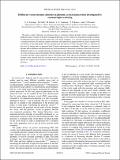Files in this item
Deliberate versus intrinsic disorder in photonic crystal nanocavities investigated by resonant light scattering
Item metadata
| dc.contributor.author | Portalupi, S. L. | |
| dc.contributor.author | Galli, M. | |
| dc.contributor.author | Belotti, M. | |
| dc.contributor.author | Andreani, L. C. | |
| dc.contributor.author | Krauss, Thomas Fraser | |
| dc.contributor.author | O'Faolain, Liam | |
| dc.date.accessioned | 2012-06-28T15:31:01Z | |
| dc.date.available | 2012-06-28T15:31:01Z | |
| dc.date.issued | 2011-07-12 | |
| dc.identifier | 18002852 | |
| dc.identifier | b5f802c9-361c-4f5c-bc1d-eb877bd231e9 | |
| dc.identifier | 000292648400006 | |
| dc.identifier | 79961182488 | |
| dc.identifier.citation | Portalupi , S L , Galli , M , Belotti , M , Andreani , L C , Krauss , T F & O'Faolain , L 2011 , ' Deliberate versus intrinsic disorder in photonic crystal nanocavities investigated by resonant light scattering ' , Physical Review. B, Condensed matter and materials physics , vol. 84 , no. 4 , 045423 . https://doi.org/10.1103/PhysRevB.84.045423 | en |
| dc.identifier.issn | 1098-0121 | |
| dc.identifier.uri | https://hdl.handle.net/10023/2874 | |
| dc.description.abstract | We report a study of photonic crystal nanocavities as a function of lattice disorder, which is implemented by deliberate radius variations of the holes forming the photonic crystal. Using cross-polarized laser light scattering, we demonstrate that lattice disorder affects the cavity mode symmetry, as is crucially evidenced by measuring scattering resonances for different sample orientations and explained by group-theoretical analysis together with calculations of the mode profile. We also quantify how the increase of lattice disorder leads to a reduction of the cavity Q factors and to a spread of both Q factors and resonance wavelengths. The trends as a function of disorder and for different radii distributions are well reproduced by theoretical calculations when both intentional (deliberate) and intrinsic (residual) disorder are taken into account. The results shed light on the effects of disorder on cavity resonances and on the interplay between intentional and intrinsic disorder, yielding reliable estimations of residual disorder (which ultimately affects technology limits) from optical measurements. Interestingly, the disorder values derived from the variation of the Q factor are lower than those derived from the wavelength spread: this suggests the occurrence of subtle interhole correlation effects that turn out to be beneficial for cavity Q factors. | |
| dc.format.extent | 9 | |
| dc.format.extent | 1099358 | |
| dc.language.iso | eng | |
| dc.relation.ispartof | Physical Review. B, Condensed matter and materials physics | en |
| dc.subject | PROPAGATION | en |
| dc.subject | SLABS | en |
| dc.subject | WAVE-GUIDES | en |
| dc.subject | QC Physics | en |
| dc.subject.lcc | QC | en |
| dc.title | Deliberate versus intrinsic disorder in photonic crystal nanocavities investigated by resonant light scattering | en |
| dc.type | Journal article | en |
| dc.contributor.sponsor | EPSRC | en |
| dc.contributor.sponsor | EPSRC | en |
| dc.contributor.institution | University of St Andrews. School of Physics and Astronomy | en |
| dc.contributor.institution | University of St Andrews. Microphotonics and Photonic Crystals Group | en |
| dc.identifier.doi | 10.1103/PhysRevB.84.045423 | |
| dc.description.status | Peer reviewed | en |
| dc.identifier.grantnumber | EP/H00680X/1 | en |
| dc.identifier.grantnumber | EP/H00680X/1 | en |
This item appears in the following Collection(s)
Items in the St Andrews Research Repository are protected by copyright, with all rights reserved, unless otherwise indicated.

